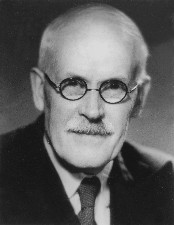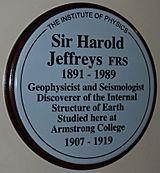Harold Jeffreys facts for kids
Quick facts for kids
Sir Harold Jeffreys
|
|
|---|---|
 |
|
| Born | 22 April 1891 Fatfield, County Durham, England
|
| Died | 18 March 1989 (aged 97) Cambridge, England
|
| Alma mater | Armstrong College St John's College, Cambridge |
| Spouse(s) | Bertha Swirles |
| Awards | Smith's Prize (1915) Adams Prize (1926) Gold Medal of the Royal Astronomical Society (1937) Fellow of the Royal Society (1925) Murchison Medal (1939) Royal Medal (1948) William Bowie Medal (1952) Guy Medal (Gold, 1962) Vetlesen Prize (1962) Wollaston Medal (1964) |
| Scientific career | |
| Fields | mathematics geophysics |
| Doctoral students | Hermann Bondi Sydney Goldstein Vasant Huzurbazar |
Sir Harold Jeffreys (born April 22, 1891 – died March 18, 1989) was a British scientist. He was a geophysicist, which means he studied the Earth's physical processes. He also made important contributions to mathematics and statistics. His book, Theory of Probability, first published in 1939, helped bring back an important way of thinking about probability called the objective Bayesian view.
Early Life and Education
Jeffreys was born in Fatfield, England. His father was a school headmaster, and his mother was a teacher. He went to his father's school and then to Rutherford Technical College. He also studied at Armstrong College in Newcastle upon Tyne, which was part of the University of Durham at the time.
Later, Jeffreys won a scholarship to St John's College, Cambridge. He was known as an excellent student there. He earned top marks in his math exams. In 1915, he received the special Smith's Prize.
Career and Discoveries
Jeffreys became a fellow at St John's College in 1914. He kept this position for 75 years, until he died. At the University of Cambridge, he first taught mathematics. Then he taught geophysics, the study of the Earth. Eventually, he became the Plumian Professor of Astronomy.
In 1940, he married Bertha Swirles, who was also a mathematician and physicist. Together, they wrote a book called Methods of Mathematical Physics.
One of his most important ideas was about the Earth's planetary core. He suggested that the Earth's core was actually liquid. This was a big discovery! He also worked a lot on the Bayesian way of understanding probability.
Jeffreys received many important awards for his work. These included the Gold Medal of the Royal Astronomical Society in 1937 and the Royal Society's Copley Medal in 1960. He was also knighted in 1953, which means he was given the title "Sir."
From 1939 to 1952, he directed the International Seismological Summary. This organization later became known as the International Seismological Centre. It helps study earthquakes around the world.
A famous book called Probability Theory: The Logic of Science was written by physicist Edwin T. Jaynes. This book is dedicated to Sir Harold Jeffreys. The dedication says, "Dedicated to the memory of Sir Harold Jeffreys, who saw the truth and preserved it."
Views on Continental Drift
Sir Harold Jeffreys had strong opinions about how the Earth's continents move. He was against the idea of continental drift. This theory, suggested by scientists like Alfred Wegener, said that continents slowly move across the Earth's surface.
Jeffreys believed that continental drift was "out of the question." He thought there wasn't a strong enough force to move huge continents. Even as more and more evidence came out in the 1960s supporting continental drift and plate tectonics, Jeffreys stuck to his original view. Plate tectonics is now the main idea that explains how the Earth's surface moves. However, Jeffreys remained against it until he died.


